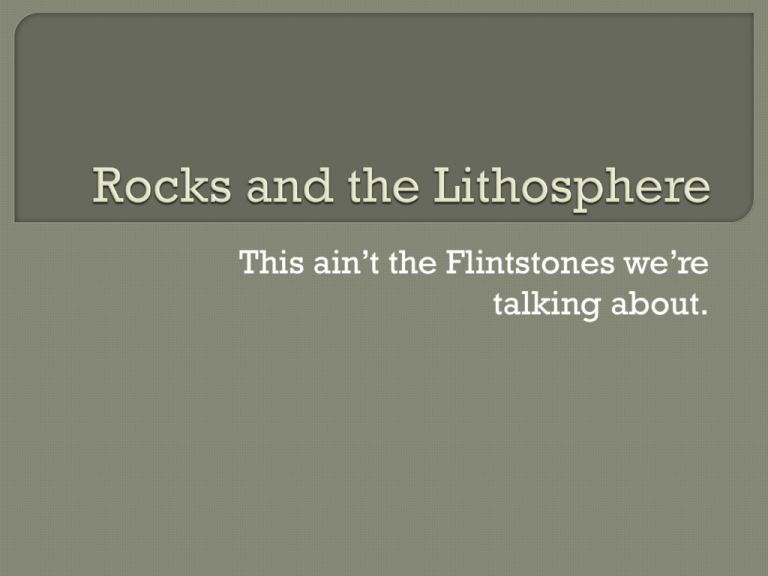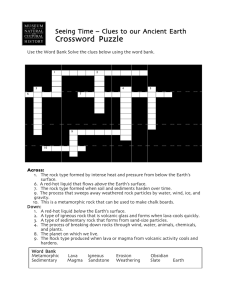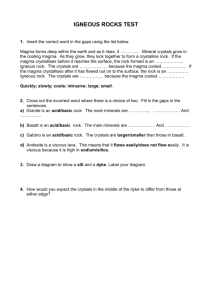Rocks and the Lithosphere
advertisement

This ain’t the Flintstones we’re talking about. All rock begins as Magma. Magma is molten rock formed beneath the Earth’s crust. As magma cools, the molecules crystallize and the material solidifies. Igneous (“formed by fire”) rock is the result of this process. Igneous rock is composed, primarily, of silicate material. Fine-grained and Coarse-grained texture are descriptions based on the size of the embedded crystals. • Fine-grain is rapidly formed near the surface. • Coarse-grain is slowly formed deep below the surface. Porphyritic texture is a mix of fine- and coarse-texture. Glassy-texture is formed when ejecta is thrown into the atmosphere and cools rapidly. Sedimentary rock is formed when weathered igneous rock is formed into a new conglomerate due to compaction and/or cementation. • Compaction is caused by deposition of material resulting in burial and immense pressures force crystals to intertwine. • Cementation is caused by additional materials, which possess adhesive qualities, binding the material together. Detrital – originate from solid particles of weathered igneous rocks. • Based on particle size. Chemical – formed from material carried in solution to lakes and seas. • Salt – deposited from salty seas. Limestone – from exoskeletons of marine invertebrates. Coquina and Chalk Travertine limestone – typically deposited in caves from dripping action of water. Coal – not formed from minerals, but from remains of pre-historic organisms. Compaction and Cementation Strata – “layers” Metamorphic means “changed in form”. Can be formed from igneous, sedimentary, or other metamorphic rock. Slight changes are termed low-grade metamorphosis. (Shale to Slate) Drastic changes are termed high-grade metamorphism. Three agents of metamorphosis – • Heat – the most important agent. The heat energy causes chemical changes whereby crystals reconfigure. Likely to happen very deep in Earth’s crust. • Pressure – also happens deep in Earth’s crust. Omnidirectional pressure compacts rock in all directions. Folding (previous slide) is graphic representation. • Chemically-active fluids – the most common is water. Water allows ions to move about in pore-spaces in rock and crystals can be changed. Foliated Rocks – derived from shale and can be split along plate lines. Examples include Slate, Schist, and Gneiss. Non-foliated Rocks – derived from limestone and will fracture under force. Examples are Marble and Quartzite. Many metallic mineral resources are igneous and metamorphic. Ores of chromium, magnetite, and platinum settle out in heavier deposits in magma chambers. (Igneous) Ores of gold, lead, zinc, and silver are formed from hydrothermal solutions. (Metamorphic)





